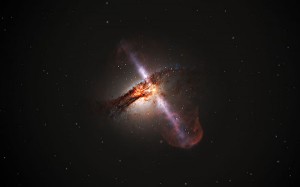
An artist’s impression of a galaxy within which lies a supermassive black hole. The black hole drives enormous outflows of plasma from the galaxy’s core which produce prodigious amounts of radio emission. In this image, the outflows travel toward the upper left and lower right. Image: ESA/Hubble, L. Calçada (ESO)
In particular, it will help astronomers understand why there are so many more young radio galaxies than old.
“We do not understand how radio galaxies evolve,” says Joseph Callingham, a postdoctoral fellow from the Netherlands Institute for Radio Astronomy (ASTRON) and lead author on the paper describing the result.
“For a long time, we thought all small galaxies evolved into massive galaxies. However, we have now found far too many small galaxies relative to the large ones. This suggests some never make it to the ‘adult phase’.”
In a survey of ninety thousand radio galaxies, the astronomers identified 1500 compact galaxies among them. The results are described in a paper published 20 February in the Astrophysical Journal.
“These compact galaxies used to be as rare as hen’s teeth,” says Prof. Bryan Gaensler, a co-author on the paper and Director of the Dunlap Institute for Astronomy & Astrophysics, University of Toronto. “But now we’ve been able to discover a huge number of new cases. This breakthrough will let us begin to study the overall properties of these unusual and important objects.”
A radio galaxy is a galaxy that shines brightly at radio wavelengths. A super-massive black hole—typically with the mass of millions of Suns—powers this outpouring of energy.
Gas and dust fall into the black hole, releasing vast amounts of energy. The energy is focused into two jets of particles, travelling in opposite directions at nearly the speed of light. As the jets blast through the galaxy, each generates its own lobe or hot-spot of radiation as it interacts with the gas in the galaxy.
According to one model, compact radio sources are young because the jets have not had time to reach far beyond the central black hole. The hot-spots are relatively close together and we see them as compact sources. Over time, the jets reach farther out into the galaxy and even beyond its confines; the hot-spots are farther from each other, and we see a more extended, double-lobed source.
In this simple model, the overabundance of young, compact radio galaxies raises the question: why don’t young, compact radio galaxies mature into old, extended radio galaxies?
However, another model argues that the relationship between the age and observed size of a radio galaxy is not so straightforward. That’s because a compact source may be compact, not because it’s young, but because gas within the galaxy is dense enough to prevent the jets from extending far from the central black hole; i.e. it remains compact despite it’s age.
“This study shows that it is possible a dense environment near the heart of the galaxy hinders and stops galaxy growth,” says Callingham, who did much of the research as a PhD student with the Australian Centre for All-sky Astrophysics (CAASTRO).
The astronomers made the discovery using data gathered with the Murchison Wide-field Array (MWA), an interferometric radio telescope in the Western Australian outback. The discovery was possible because, unlike conventional radio telescopes that observe tiny patches of the sky at a time, the MWA sweeps large areas of the sky and is capable of observing across a broader range of wavelengths.
Additional notes:
1) The Murchison Wide-field array combines the signals from over 2000 separate antennas. With an area of 2000 square metres, it has a collecting area equivalent to a conventional radio telescope dish. The MWA is located at the Murchison Radio Astronomy Observatory, the future Australian site of the Square Kilometre Array, around 700 kilometres north of Perth in Western Australia. Over the past three years, it has been used to survey 90% of the southern sky.
2) For more on the GaLactic and Extragalactic All-sky MWA (GLEAM) survey of 300,000 galaxies: http://www.icrar.org/gleam/
-30-
Extragalactic Peaked-Spectrum Radio Sources at Low Frequencies
Dr. Joseph Callingham
ASTRON Postdoctoral Fellow
Netherlands Institute for Radio Astronomy (ASTRON)
Netherlands Organisation for Scientific Research (NWO)
p: +31 521 595 785
e: callingham@astron.nl
Prof. Bryan Gaensler, Director
Dunlap Institute for Astronomy & Astrophysics
University of Toronto
p: 416-978-6623
e: bgaensler@dunlap.utoronto.ca
Dr. Wiebke Ebeling
Education & Outreach
ARC Centre of Excellence for All-sky Astrophysics (CAASTRO)
Curtin Institute of Radio Astronomy
Curtin University
Bentley WA 6102, Australia
p: +61 8 9266 9174
e: wiebke.ebeling@curtin.edu.au
Chris Sasaki
Communications Co-ordinator
Dunlap Institute for Astronomy & Astrophysics
University of Toronto
p: 416-978-6613
e: csasaki@dunlap.utoronto.ca
w: dunlap.utoronto.ca
The Dunlap Institute for Astronomy & Astrophysics at the University of Toronto is an endowed research institute with over 40 faculty, postdocs, students and staff, dedicated to innovative technology, ground-breaking research, world-class training, and public engagement. The research themes of its faculty and Dunlap Fellows span the Universe and include: optical, infrared and radio instrumentation; Dark Energy; large-scale structure; the Cosmic Microwave Background; the interstellar medium; galaxy evolution; cosmic magnetism; and time-domain science.
The Dunlap Institute, Department of Astronomy & Astrophysics, Canadian Institute for Theoretical Astrophysics, and Centre for Planetary Sciences comprise the leading centre for astronomical research in Canada, at the leading research university in the country, the University of Toronto.
The Dunlap Institute is committed to making its science, training and public outreach activities productive and enjoyable for everyone, regardless of gender, sexual orientation, disability, physical appearance, body size, race, nationality or religion.
###
